Nissan’s Z-car may have been the first Japanese sports car to make a real splash in the United States back in 1969 – but crosstown rival Toyota wasn’t going to sit on its hands indefinitely.
Especially since Toyota had technically beaten the Z-car to the punch by four years with the stunning 2000GT – which made its debut at the 1965 Tokyo Motor Show. Unfortunately (for Toyota) the aluminum-bodied, in-line six-powered 2000 GT was both complex and expensive; it was also produced in extremely low numbers – appx. 351 examples, total, with only about 60 of those making it to America – and for just three full years (1967-’70), after which the program was cancelled.
Datsun sold more 240Zs in a month.
By the early-mid ’70s, the Z-car was making huge inroads against clumsy-handling, gas-guzzling and increasingly wheezy (thanks to Uncle) American muscle cars – and also against the still quick and nimble but not-so-reliable British sports cars of the era.
Toyota desperately wanted to get back into the game.
There was the Celica – a sporty, rear-drive, two-plus-two. It came to market shortly after the Datsun 240Z, in 1971. But the Celica was a slightly sexier economy car compared with the athletic, purpose-built Z-car, which also featured a standard in-line six vs. the much less prestigious – and much less powerful – four-cylinder found in the Celica.
But it was a start.
With the guiding spirit of the 2000GT in mind, Toyota engineers began work on a new kind of Celica – one that would (in time) prove the equal of the Z-car.
At first, the car was basically a stretched and hopped-up version of the Celica. The inaugural 1979 Mk I model shared the same basic chassis (including the solid rear axle/RWD layout) but was 5.1 inches longer than the standard Celica. This necessitated different sheetmetal in several areas, including the rear quarter panels. There was also a 2000GT-inspired front-end treatment and wider B pillars to give the car a more aggressive look.
But the really important difference was under the hood.
Instead of the Celica’s MPG-mindful four-cylinder engine, Toyota engineers endowed the first Supra with a 2.6 liter in-line SOHC six – a clear shot across the bow aimed directly at the Nissan Z-car. This engine developed 110-hp (initially) and was the first Toyota production engine to be fitted with electronic fuel injection as standard equipment.This was a rare feature in the late ’70s that would not see widespread use in American cars until well into the mid-late 1980s.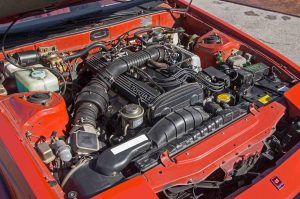
Like its spiritual forebear the 2000GT, that first-year Celica Supra also came standard with four-wheel disc brakes – another rarity back in ’79 – as well as a 5-speed manual gearbox (with a four speed automatic available optionally) and a sport-tuned suspension and gauge pack with tachometer – yet another “something” that wasn’t commonly found in most cars, even sporty ones, until many years later.
At first, the cars came through with stamped steel wheels and plastic trim covers – just like the early Z-cars. But by 1980, these were tossed in favor of 14×5.5-inch aluminum alloys. Another functional improvement came in 1981, when the displacement of the SOHC six was upped to 2.8 liters (and power output ticked up slightly to 116 hp, net).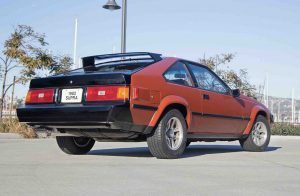
The Mk I ’79-’81 Celica Supra was took about 11 seconds to get to 60 and had top speed of about 115 mph. In the late ’70s/early ’80s, these were solid numbers – not too far off the pace of contemporary V8 muscle cars such as the Chevy Camaro Z28 or Pontiac’s Firebird Trans-Am, both of which were much heavier and gimped by progressively detuned engines (courtesy of Uncle).
And the Celica offered much better balance, braking and handling – very much like its Nissan rival. Total production of the Mk I was approximately 63,895 units.
Still, it was only a beginning. There was more work yet to do.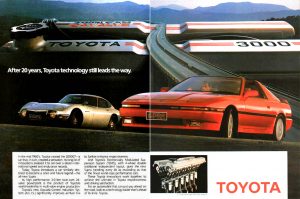
In 1982, the second generation Celica Supra bowed – with major changes evident throughout, including a new dual overhead cam (DOHC) 2.8 liter in-line six, now rated at 145 hp. The Mk II was offered in two forms: enthusiast-oriented P-type (for “performance”) or softer, luxury-oriented L-type. While both used the same engine, P-types came through with a more aggressive final drive ratio (4.10 or 4.30) while the L-types were fitted with a 3.727:1 ring and pinion for better fuel economy and less engine buzz at highway speeds.
The “Ps” were hunkier looking, too – with wider rims (14x7s and 225/60-series performance tires vs. 14×5.5-inchers and P195/70-14 all-seasons), pronounced fiberglass fender flares and a wild (for the time) rear spoiler. Form-fitting sport buckets on the inside with driver-adjustable manual lumbar support and side bolsters – also uncommon at the time – were also part of the package, with a limited slip differential available optionally.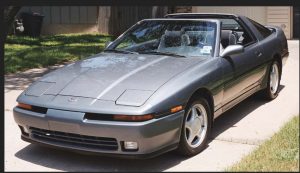
The Mk II’s modified Macpherson strut (front) and semi-trailing line (rear) suspension was tuned by Lotus and by ’85 – the final year for the second generation cars – power output was up to 165 hp. Straight line performance and handling had improved dramatically compared with the original ’79-’81 versions. The car was now capable of reaching 60 mph in about 8.7-8.9 seconds; top speed edged close to 130 mph – very competitive with same-era American muscle cars like the Mustang GT 5.0 and Chevy Camaro Z28 IROC-Z.
The Supra was maturing into an impressive GT coupe that was rapidly closing the distance between itself and more established competitors – with new competitors like the Corvette now in its gunsights.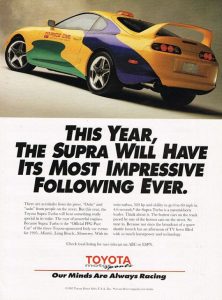
1986 saw the introduction of an all-new Mk III, the first year for a Supra that was no longer also a Celica – in name or otherwise. Beginning with this model year, the two cars went their separate ways – with Supra becoming an all-out (and rear-drive) high-performance super coupe that shared nothing with its now front-wheel-drive, toned-down forbear except the Toyota nameplate.
A new 3-liter six cylinder engine was now standard, with output finally cresting the 200 hp mark for the first time. But this was merely the Supra’s standard engine. For buyers with a real need for speed, Toyota offered a turbocharged version of this engine – beginning with the ’87 models – that was good for 230-hp, dropping the car’s 0-60 times to just over six seconds.
The turbo engine featured coil-on-plug ignition – the first production application of this now-common technology in a Toyota vehicle. Four channel ABS, traction control and an electronically adjustable suspension system called TEMS, or Toyota Electronically Modulated Suspension were among the very high-tech for the times equipment found in the Mk IIIs.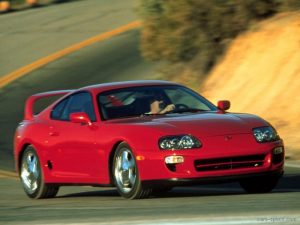
A targa-style roof was available, too.
In ’88, Toyota released a low-volume Turbo-A model designed to compete in Group-A Touring Car championships. A high-pressure (7.8 psi) turbo, more aggressive cams and high-flow injectors goosed output to 263-hp, making the Turbo-A Supra the fastest Japanese production car then available. Just 500 of these very special Supras left the factory – all of them black hardtop coupes with custom-fitted leather interiors.
The Mk III had a long production run, lasting through the ’92 model year – almost twice the three-year shelf-life of the Mk I and Mk II Celica Supras. However, while performance continued to grow sharper with each passing year, the Supra was gradually transforming into an expensive semi-exotic – with an equally semi-exotic price tag: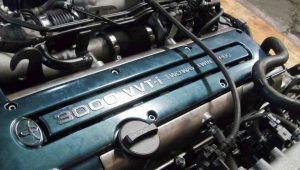
$25,280 for the base car without the turbo; $28,750 with. In 2020 money that comes to around $53,000 . . . to start. This was only slightly less expensive than the price of a ’92 Corvette, which stickered for $33,635 to start (about $62k today).
The upward trend in power – and price – continued with the introduction in 1993 of the Mk IV Supra – which sported an available twin-turbo 3-liter engine and 320-hp (a 220-hp non-turbo engine was still standard equipment).
Twin-turbo models also received a new Getrag six-speed manual transmission, 17-inch rims (16s were standard on the non turbo cars) and 4-piston brakes, among other upgrades. In addition, Mk IVs also had aluminum hoods, magnesium steering wheels and lightweight suspension pieces to shave weight and reduce unsprung mass. Toyota’s variable valve timing (VVTi) system appeared in ’98, by which time the Supra was at the pinnacle of its technological development and performance capability. A twin-turbo Supra could deliver 0-60 times of 4.6 seconds and quarter mile runs in the high 12 second range at nearly 110 mph.
These numbers made it one of the world’s quickest street cars at the time. Even by today’s standards, nearly 30 years later, a 4.6 second 0-60 time is still supercar quick.
But the base price of a Mk IV Supra was now almost $34,000 – about $63,000 today – and turbo models were pushing $40k. This was yuge money in the early-mid ’90s – and it just happened that the market for powerful coupes took a nosedive during this period. Sales slumped badly, despite the objective fact that the Mk IV was without question the quickest, fastest, best-handling and most formidable Supra of them all.
It is an irony of history that both the Supra and its crosstown nemesis, the Nissan 300ZX, eventually fell victim to their own over-achievement.
By the mid-late ’90s, each car had developed into a true Ninja from fairly humble beginnings – and each suffered declining sales interest as ever-improving performance tracked with ever-escalating price. Nissan eventually dropped the Z-car and Toyota did the same with its Supra, pulling it from the U.S. market after 1998 – and canceling it entirely after 2002.
The Z-car, of course, made a comeback.
And so has the Supra, which returns this year as the Supra GR. Taking a page from the past, the new Supra costs less than the last Supra – just $49,990 in today’s money. Which means it costs about $10k less in real terms than the last new Supra you could buy – almost 20 years ago.
Like the original Supra, the new one is light and relatively simple – and it has a 3 liter in-line six. But this ones makes 335 hp.
Which raises the bar, again.
Got a question about cars, Libertarian politics – or anything else? Click on the “ask Eric” link and send ’em in!
If you like what you’ve found here please consider supporting EPautos.
We depend on you to keep the wheels turning!
Our donate button is here.
If you prefer not to use PayPal, our mailing address is:
EPautos
721 Hummingbird Lane SE
Copper Hill, VA 24079
PS: Get an EPautos magnet or sticker or coaster in return for a $20 or more one-time donation or a $10 or more monthly recurring donation. (Please be sure to tell us you want a magnet or sticker or coaster – and also, provide an address, so we know where to mail the thing!)
If you’d like an ear tag – custom made! – just ask and it will be delivered.
My latest eBook is also available for your favorite price – free! Click here. If that fails, email me at EPeters952@yahoo.com and I will send you a copy directly!


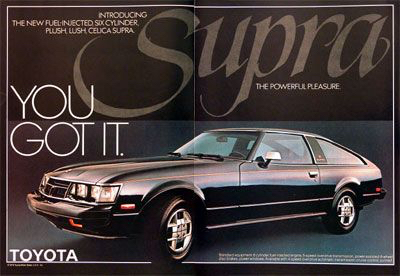


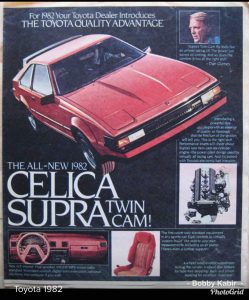







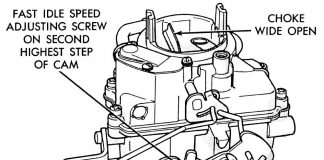
The first gen handled like a pig riding a skateboard. They wallowed and had terrible understeer (I still have the R&T article complaining about it) I used to borrow my friend’s ’79 when we were coworkers, and it was very soft, it had a great ride though. And that engine was sooooo smooth!! Even being a decade old at the time, if felt tight like a new car.
I almost bought an 82′ but couldn’t handle those squared off wheel wells.
One of the downsides of today’s front wheel drive economy cars, is they will no longer spawn affordable performance variants. The Mustang was borne of the Falcon, the Supra of the Celica etc. The Mustang would have never come from a Focus, nor will the Supra come from a Corolla. Both the Corolla and Focus are nice cars, but they cannot birth something affordable that the automakers could do with the old stuff. And that is the key, the affordability that has been lost. The Mustang was a huge success not just because it was good. It was because joe six pack could afford to buy one.
Maybe its part of the reason there aren’t new ICON’s (like the other article you wrote recently).
Actually, the Celica did come from the Corolla, but that was when the Corolla was RWD. 😊
Okay Eric, I want one.
Notice how the ads back then emphasized the mechanics / engineering of the vehicle. Actually showing the engine and such. That I6 actually looks really good. Something nice to stare at. Advertising the real purpose, motion.
Now it’s just, what, the touchscreen and apps? Advertising anything to distract you from the real purpose, motion. I can’t remember the last time I saw a car ad that showed a picture of the engine.
Well, just looked at the prices for supras. Nevermind.
If you have 20K to spare a Butler Ram Air V big bock in that Poncho would be a throttle steer joy ride like none other! My dream Pontiac is this motor in a tribute 69 T/A convertible. WoooHooo!! https://butlerperformance.com/i-24487141-bp-crate-engine-505-541-cu-in-w-iaii-block.html?ref=category:1267471
What a proud history the Toyota Supra had.
Now, that company has sold its soul, degrading itself to the point where they will slap the Supra badge on some other automaker’s product.
Viewed objectively, the new Supra (at least the one with the turbo,) is an impressive machine. But it leaves a bad taste in my mouth. I wouldn’t have one if they gave it to me free.
Yeah, and in terms of reliability, Toyota and BMW aren’t even in the same church, let alone the same pew.
Hi Myles,
I’d much rather have a classic Supra than the new one for that and other reasons. I like my cars to match. If the badge says Pontiac, it had better have a Pontiac engine under its hood. Etc.
You’re right Miles. My new Gen III Turbo Supra was just as reliable as any Tacoma or Camry……with one huge exception…..Blown Head Gaskets.
My head gasket blew under “arduous” driving conditions, (low triple digits in 100+ air temp.) It didn’t die at roadside. Just a low but loud pop, with a 20% power loss. Car ran weak and rough for about a month, till I got it fixed.
I figured my driving style had exposed a minor weakness that might go undiscovered in most Turbos. But two of my friends loved the looks of my Turbo Supra so much that they each bought one of their own. They got autos (mine was a stick,) and being females, they drove them more gently. But within a year of purchase, both their Turbo Supras blew head gaskets too.
When I saw that, I decided to bail.Traded it in for a new 5 cyl turbo Volvo wagon. It was a nice combo of surf wagon/real estate car. But turbo or not, the Thrill was gone.
My first car was a USDM 1982 Celica GT. Great car for a young kid. It taught me RWD driving dynamics, and was sufficiently gutless to keep me out of trouble. I’d love a GT-S or a Supra from that era. I think the styling holds up.
Wow, I forgot how much I loved those early Celica’s cause of the RWD. I tried to get one from a neighbor but he wouldn’t let it go. Unfortunately, I had to go honda civic cause they were plentiful and cheap when they let go the head gasket at 40-80K and don’t forget the timing belt had to be changed around then too, so I picked up a lot of bent-valved honda’s, fixed them, and these cars became my pass into affording college.
And then the Supra! OMG how I lusted for one of them. One of my friends in college had one. I was fortunate to be able to pick up a broken mid-80’s Civic SI, and I liked it a lot, until I wrapped it around a pole.
I even auto-crossed that car and came within .1 seconds of beating a RX-7 once, haha…
Fun reflection. Thanks Eric.
ps: i just saw my first brandy new Supra, I almost hit it too cause it’s so freaking low that I couldn’t see it next to my truck. They look very cool, but way smaller than the old days.
Back in the days of carburetors and pushrod overhead valves, one horsepower per cubic inch was about as high as production engines went.
For instance, the 427 cubic inch L71 engine in the 1968 Corvette claimed 435 hp @ 5,800 rpm, in an era when OEMs had a little more “leeway” to put a rosy glow on specs.
Whereas today, the Supra GR’s 335 hp from 183 cubic inches represents 1.83 horsepower per cubic inch.
It’s pretty amazing that IC engine technology dating from the 19th century could be tweaked to hike power output so much more in the last 50 years.
Too bad black-box computer controls make it so hard to retrofit these modern-marvel power plants to older vehicles. Philistines are sticking electric motors into classic vehicles because it’s the path of least resistance, with the electric propulsion system being largely self-contained.
Meanwhile, Prophet Elon (peace be upon him) has announced September 22 as “battery day.” It will change the world about as much as, say, the now-discontinued Segway, launched with similar over-the-top PR hype.
Apples to oranges. Many modern cars have high specific power output (power per unit displacement) due to forced induction.
Hi Jim,
Yup! Modern roller cams can really amp up the power of an older engine, too – without (as with flat tappet cams) killing the drivability. That plus modern heads for the old stuff and you’re cooking. Plus, you don’t need to make as much power because the old stuff is generally much lighter. My ’76 TA for instance is about 400 pounds lighter than a new V8 R/T Challenger.